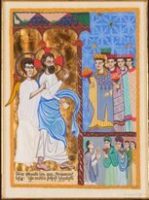The Vessel and Doorway to our Salvation

Go to your church and look upward above the Altar toward her dominating presence, where she is seated upright, and majestic – in a commanding position upon a throne.
Immediately she captures our eyes and all our senses, as she presents to the faithful, the Son of God with His right hand offering a blessing. As she is seated on a throne, she herself becomes the throne for the Saviour of all humankind and a doorway for us to His Throne in Heaven.
Behold the Christ child seated either on her left knee sometimes couched or leaning on her bosom, St Mary gazes with no specific point of contact but looks everywhere. Her right and left hands lovingly embrace the infant whose facial expression, unlike an innocent newborn, is mature showing thus God’s Divine Wisdom. Interestingly His aged facial expression springs forth from the Old Testament’s prophetic description in the Book of Daniel 7:13
13 In my vision at night I looked, and there before me was one like a son of man,[a] coming with the clouds of heaven. He approached the Ancient of Days and was led into his presence. 14 He was given authority, glory and sovereign power
The Holy Mother and the Lord -King of all- are both clothed in majestic robes of colors. Reds, blues, or purple all have a significant meaning in Christian art. Both the inner and outer garments they are allegorically likened to God himself clothing His Christ the Messiah. There are differing schools of thought used by Iconographers and Illumination artists, in using these colors; some from Eastern and Oriental Orthodox Iconography, and some from the Iconography of the Latin West.
For example, some icons of the Virgin’s outer mantel use red, whereas others present her attired in a blue mantel. These variation spring from two differing interpretations, yet both acceptable in our Church’s iconography of her.
St Mary, clothed in Blue the color of the sky and viewed as a heavenly color presents her in transcendence, mystery, with the divine one. On the other hand, when dressed with a Red outer garment the Icon tells us that God has clothed humanity with his Divinity.
Interestingly also, Purple, the color of the emperors- nobility, and royalty in all classes and associated with wealth and power, is used for the outer mantel of the Virgin from the royal House of David.
Armenian sacred art is diverse in the use of blue, red and purple and often depicts St. Mary dressed in a red outer garment and a blue inner garment, representing how she carried the mystery of divinity (Jesus) in her humanity or in the reverse. The Virgin’s outer garment is laced with a golden fringe and tassels, also part of royal attire.
In most Icons, her left, right shoulders and the center of her forehead show a * star or Diadem. Symbolically this design was even used in pre-Christian art indicating royalty. The star represents a Crown and identifies one as a monarch. The three Diadems give the same message. St. Mary, the Mother of God carried the responsibility upon her shoulders to be the bearer of the Divine within upon her as the Queen of Heaven crowned with a Diadem resting on her head.
Christ the King of Glory dressed in a tunic often gold or gold ochre, with his right-hand offers a benediction to the faithful. In His left hand sometimes Jesus holds either an orb, signifying the earth, or other times a scroll, – the Book of Eternal Life.
Iconographers may choose to use white to cover His body instead. At birth, Jesus was wrapped in white swaddling bands of babies, and at his death with the white burial cloths. White is the color of purity, cleanness, innocence, and the mystical “uncreated light” Christ Himself shown to Peter, James, and John at the Transfiguration.
Both mother and child are graced with halos, but note, Christ’s is unique, with an inscribed Cross. In the middle arm of the Cross in His halo behind his head is the Armenian letter eh Է which declares His Divinity with the Godhead. This echoes the words from the Gospel of Saint John …In the beginning, was the Word, and the Word was with God, and the Word was God [John 1: 1}
From Christ God’s birth to His crucifixion, Resurrection, and Ascension, the Holy Mother has been and will forever remain for us who pray to her our prime intercessor to her Son. Her sanctified and her humanity, perfected by her obedience in accepting the will of God, she becomes an important stepping stone toward the roadway to salvation.
Her Icon then is a constant reminder to live according to the will of God and to be as perfect as our Father in heaven is perfect.


